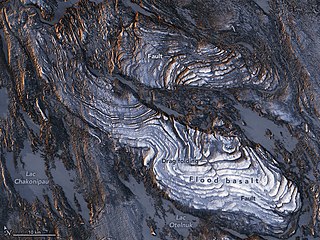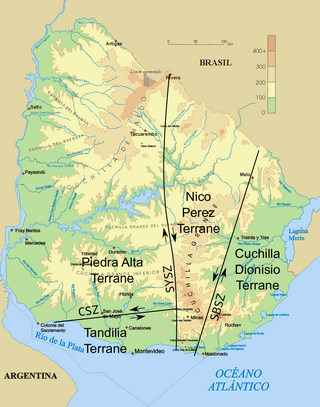Related Research Articles
The Penokean orogeny was a mountain-building episode that occurred in the early Proterozoic about 1.86 to 1.83 billion years ago, in the area of Lake Superior, North America. The core of this orogeny, the Churchill Craton, is composed of terranes derived from the 1.86–1.81 Ga collision between the Superior and North Atlantic cratons. The orogeny resulted in the formation of the Nena and Arctica continents, which later merged with other continents to form the Columbia supercontinent. The name was first proposed by Blackwelder 1914 in reference to what is known as the Penokee Range, sometimes incorrectly called the Gogebic Range, in northern Michigan and Wisconsin.

The Yilgarn Craton is a large craton that constitutes a major part of the Western Australian land mass. It is bounded by a mixture of sedimentary basins and Proterozoic fold and thrust belts. Zircon grains in the Jack Hills, Narryer Terrane have been dated at ~4.27 Ga, with one detrital zircon dated as old as 4.4 Ga.

The geology of Antarctica covers the geological development of the continent through the Archean, Proterozoic and Phanerozoic eons.

The Rio de la Plata Craton (RPC) is a medium-sized continental block found in Uruguay, eastern Argentina and southern Brazil. During its complex and protracted history it interacted with a series other blocks and is therefore considered important for the understanding of the amalgamation of West Gondwana. Two orogenic cycles have been identified in the RPC: a 2000 Ma-old western domain representing the old craton and a 700–500 Ma-old eastern domain assigned to the Brasiliano Cycle. It is one of the five cratons of the South American continent. The other four cratons are: Amazonia, São Francisco, Río Apa and Arequipa–Antofalla.

The Labrador Trough or the New Quebec Orogen is a 1,600 km (994 mi) long and 160 km (99 mi) wide geologic belt in Canada, extending south-southeast from Ungava Bay through Quebec and Labrador.

The Circum-Superior Belt is a widespread Paleoproterozoic large igneous province in the Canadian Shield of Northern, Western and Eastern Canada. It extends more than 3,400 km (2,100 mi) from northeastern Manitoba through northwestern Ontario, southern Nunavut to northern Quebec and into western Labrador. Igneous rocks of the Circum-Superior Belt are mafic-ultramafic in composition, deposited in the Labrador Trough near Ungava Bay, the Cape Smith Belt near the southern shore of Hudson Strait and along the eastern shore of Hudson Bay in its northern portion; the Thompson and Fox River belts in the northwest and the Marquette Range Supergroup in its southern portion. The Circum Superior Belt also hosts a rare example of Proterozoic Komatiite, in the Winnipegosis komatiite belt.
The West African Craton (WAC) is one of the five cratons of the Precambrian basement rock of Africa that make up the African Plate, the others being the Kalahari craton, Congo craton, Saharan Metacraton and Tanzania Craton. Cratons themselves are tectonically inactive, but can occur near active margins, with the WAC extending across 14 countries in Western Africa, coming together in the late Precambrian and early Palaeozoic eras to form the African continent. It consists of two Archean centers juxtaposed against multiple Paleoproterozoic domains made of greenstone belts, sedimentary basins, regional granitoid-tonalite-trondhjemite-granodiorite (TTG) plutons, and large shear zones. The craton is overlain by Neoproterozoic and younger sedimentary basins. The boundaries of the WAC are predominantly defined by a combination of geophysics and surface geology, with additional constraints by the geochemistry of the region. At one time, volcanic action around the rim of the craton may have contributed to a major global warming event.
The Cheyenne Belt is the tectonic suture zone between the Archean-age Wyoming craton to the north and the Paleoproterozoic-age Yavapai province to the south. It runs through the southeastern quadrant of the state of Wyoming, United States. It was formed during the Paleoproterozoic Medicine Bow orogeny between 1.78 and 1.74 billion years ago when island arcs collided with the Wyoming craton. This is an example of a convergent boundary in tectonics.

The geology of Uruguay combines areas of Precambrian-aged shield units with a region of volcanic rock erupted during the Cretaceous and copious sedimentary facies the oldest of which date from the Devonian. Big events that have shaped the geology of Uruguay include the Transamazonian orogeny, the breakup of Rodinia and the opening of the South Atlantic.

The East Antarctic Shield or Craton is a cratonic rock body that covers 10.2 million square kilometers or roughly 73% of the continent of Antarctica. The shield is almost entirely buried by the East Antarctic Ice Sheet that has an average thickness of 2200 meters but reaches up to 4700 meters in some locations. East Antarctica is separated from West Antarctica by the 100–300 kilometer wide Transantarctic Mountains, which span nearly 3,500 kilometers from the Weddell Sea to the Ross Sea. The East Antarctic Shield is then divided into an extensive central craton that occupies most of the continental interior and various other marginal cratons that are exposed along the coast.

The Sveconorwegian orogeny was an orogenic system active 1140 to 960 million years ago and currently exposed as the Sveconorwegian orogenic belt in southwestern Sweden and southern Norway. In Norway the orogenic belt is exposed southeast of the front of the Caledonian nappe system and in nappe windows. The Sveconorwegian orogen is commonly grouped within the Grenvillian Mesoproterozoic orogens. Contrary to many other known orogenic belts the Sveconorwegian orogens eastern border does not have any known suture zone with ophiolites.

The Pampean orogeny was an orogeny active in the Cambrian in the western margin of the ancient landmass of Gondwana. The orogen's remains can now be observed in central Argentina, in particular at the Sierras de Córdoba and other parts of the eastern Sierras Pampeanas. It is uncertain if the orogeny involved at some point a continental collision. The Pampean orogen can be considered both part of the larger Terra Australis orogen and of the Brasiliano orogeny. The Pampean orogeny was succeeded by the Famatinian orogeny further west.

Choiyoi Group is a Permian and Triassic-aged group of volcano-sedimentary formations in Argentina and Chile. The group bears evidence of bimodal-style volcanism related to an ancient subduction zone that existed along the western margin of the supercontinent Gondwana.

The Uruguayan dyke swarms consist of three dyke swarms of Precambrian age that intrude Río de la Plata Craton and Brasiliano Cycle continental crust in Uruguay. The dykes – including the Florida dyke swarm, the Nico Perez dyke swarm, and the Treinta y Tres dyke swarm – are of mafic to intermediate composition and each group lies in a separate tectono-stratigraphic terrane. The rocks of the Florida dyke swarm have been quarried since the 1960s and are used in the construction industry as black dimension stone of very high quality, being marketed as "black granite".
Illescas Batholith is a geological complex located in Uruguay made up of various plutons including rapakivi granite and quartz syenite. The batholith is of Late Paleoproterozoic age. The batholith originated and was emplaced in an anorogenic tectonic setting during a period of extensional tectonics. The batholith intrudes the Valentines Granulitic Complex of Nico Perez Terrane. The Florida dyke swarm is related to the Illescas Batholith.
The Satakunta dyke swarms are a series of dyke swarms, a group of magmatic intrusions, of Mesoproterozoic age in the Bothnian Sea and western and central Finland. They are made up of Subjotnian diabase dikes, associated with rapakivi magmatism. They were most likely formed on the Columbia supercontinent.
The Grenville Province is a tectonically complex region, in Eastern Canada, that contains many different aged accreted terranes from various origins. It exists southeast of the Grenville Front and extends from Labrador southwestern to Lake Huron. It is bounded by the St. Lawrence River/Seaway to the southeast.
The geology of Brazil includes very ancient craton basement rock from the Precambrian overlain by sedimentary rocks and intruded by igneous activity, as well as impacted by the rifting of the Atlantic Ocean.

The geology of Peru includes ancient Proterozoic rocks, Paleozoic and Mesozoic volcanic and sedimentary rocks, and numerous basins and the Andes Mountains formed in the Cenozoic.

The geology of the Kimberley, a region of Western Australia, is a rock record of the early Proterozoic eon that includes tectonic plate collision, mountain-building (orogeny) and the joining (suturing) of the Kimberley and Northern Australia cratons, followed by sedimentary basin formation.
References
- 1 2 3 Iacumin, M.; Piccirillo, E.M.; Girardi, V.A.V.; Teixeira, W.; Bellieni, G.; Echeveste, H.; Fernández, R.; Pinese, J.P.P.; Ribot, A. (2001). "Early proterozoic calc-alkaline and middle proterozoic tholeiitic Dyke Swarms from Central–Eastern Argentina: petrology, geochemistry, Sr–Nd isotopes and tectonic implications". Journal of Petrology . 42 (11): 2109–2143.
- ↑ Lajoinie, M.F.; Etcheverry, R.O; Lanfranchini, M.E.; Cábana, C. (2014). "Geología, geoquímica y génesis de diques proterozoicos del área de San Miguel, sierras septentrionales de la provincia de Buenos Aires". Revista de la Asociación Geológica Argentina (in Spanish). 71 (3): 404–415. Archived from the original on 2021-04-20. Retrieved 2016-09-18.
